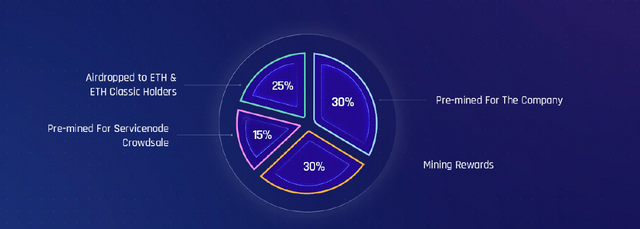
Cryptocurrencies have grown substantially - and we can all agree on one thing… this is only the beginning. However, as cryptocurrencies grow, it becomes obvious that there are certain limitations, when it comes to how big a coin’s user base can be. For example - Bitcoin is big, Ethereum is big, and Litecoin is big, but it isn’t exactly possible for any one of those coins to become "the" cryptocurrency that the world uses.
Cryptocurrencies and Blockchains
The year 2008 will remain an important year in the history of cryptocurrencies. This was the year when the domain name Bitcoin.org was registered. Later in the same year, a paper titled “Bitcoin: A Peer-to-Peer Electronic Cash System” [1], authored by a pseudonym “Satoshi Nakamoto” was posted.
In 2009, Bitcoin came into existence, with the release of the first Bitcoin client, and the issuance of the first block (the genesis block) on the Bitcoin network.
Since then, we have seen a proliferation of cryptocurrencies and a multitude of blockchains. One very interesting after-effect of cryptocurrencies’ initial surge of popularity was the application of blockchain technology in areas other than cryptocurrencies, with the main idea of harnessing it as a platform for enabling decentralization while retaining trust.
Limitations of Current Blockchain Solutions
Traditional blockchain technologies face several practical issues, which are hindering the adaptation of these technologies into mainstream use. We will be focusing on the blockchain technology implemented in Bitcoin as the central case study to demonstrate its limitations. We believe that the blockchain mechanisms used in Bitcoin are well-established, and have the largest base of installations as of this writing. Further, most other cryptocurrencies use similar concepts in their blockchains. Hence, we believe the limitations that Bitcoin faces are representative of those that are faced by other cryptocurrencies as well.
Existing Work
Unlike other solutions such as Dash[28], which are specific implementations of blockchain, Laser is geared to work with any blockchain, without any need for changes in the underlying protocol. Additionally, the functionality enhancement to utilize the added services of Laser is limited to the full nodes or the validator nodes – not the other parts of the network. This allows multiple blockchains to interoperate parallel to one another while retaining each blockchain’s built-in security properties.
Most of the current solutions for interoperability across blockchains are either limited to inter-chain transactions of native currency across the participating blockchains (such as Metronome[26]), or they are limited by compliance requirements of the participating blockchain. For instance, AION[27] needs a participating blockchain to implement the ‘locktime’ feature, which is not present in IOTA. Such compliance requirements limit the applicability of the solution – and in turn, the adoptability of the solution in the market.
With our current approach, the only compliance requirement for the participating blockchains is to have the multi-signature capability, which is present in almost all blockchains. This easy-to-meet compliance requirement will allow for very easy adoption of our solution.
Proposed Solution for Better Privacy, Faster Transactions, and Better Interoperability
In this paper, we propose a solution to address the issues of privacy, near-instant transactions, and inter-chain operability. We introduce a service layer that is made up of full nodes.
This layer, termed the servicenode layer, will help in achieving a more secure and robust blockchain network.
The design of Laser provides for incentivization of the nodes which form the servicenode layer for providing its services. This will cultivate strong user interest in operating such nodes – to the benefit of both the servicenode layer, and every blockchain on which it operates.
Laser Blockchain
We propose the launch of a blockchain called Laser by hard-forking the Ethereum blockchain. We will also introduce a new cryptocurrency called Photon as part of the Laser blockchain.
All holders of Ethereum (ETH) and Ethereum Classic (ETC) before the hard fork will receive an equal number of Photons on upgrading their software.
Initial Distribution of Photons
The total supply of Photons will be capped at 42 million units.
All ETH and ETC holders will be entitled to Photons under the proposed distribution plan, as below.

30% (12.6 million Photons) will be pre-mined for the company.
15% (6.3 million Photons) will be pre-mined for the servicenode crowdsale.
30% (12.6 million Photons) will be generated by the miners. Note that eventually the mining will be replaced with PoS by Q4 2018.
25% (10.5 million Photons) will be airdropped to Ethereum and Ethereum classic holders. The Photons allotted to the Ethereum and Ethereum Classic holders will be 5% of their current holdings.
Current holders of Ethereum and Ethereum Classic will be incentivized to begin staking on the Laser network through a targeted airdrop. Currently it is estimated that they will be rewarded with a yearly payout of 36% in Photons
Roadmap

| Website | Whitepaper | Twitter | Facebook | Telegram | ANN Thread |
mybitcointalk : https://bitcointalk.org/index.php?action=profile;u=894352
Hi! I am a robot. I just upvoted you! I found similar content that readers might be interested in:
https://bitcoinexchangeguide.com/laserico/
Downvoting a post can decrease pending rewards and make it less visible. Common reasons:
Submit
Congratulations @rrslemon! You received a personal award!
You can view your badges on your Steem Board and compare to others on the Steem Ranking
Do not miss the last post from @steemitboard:
Vote for @Steemitboard as a witness to get one more award and increased upvotes!
Downvoting a post can decrease pending rewards and make it less visible. Common reasons:
Submit